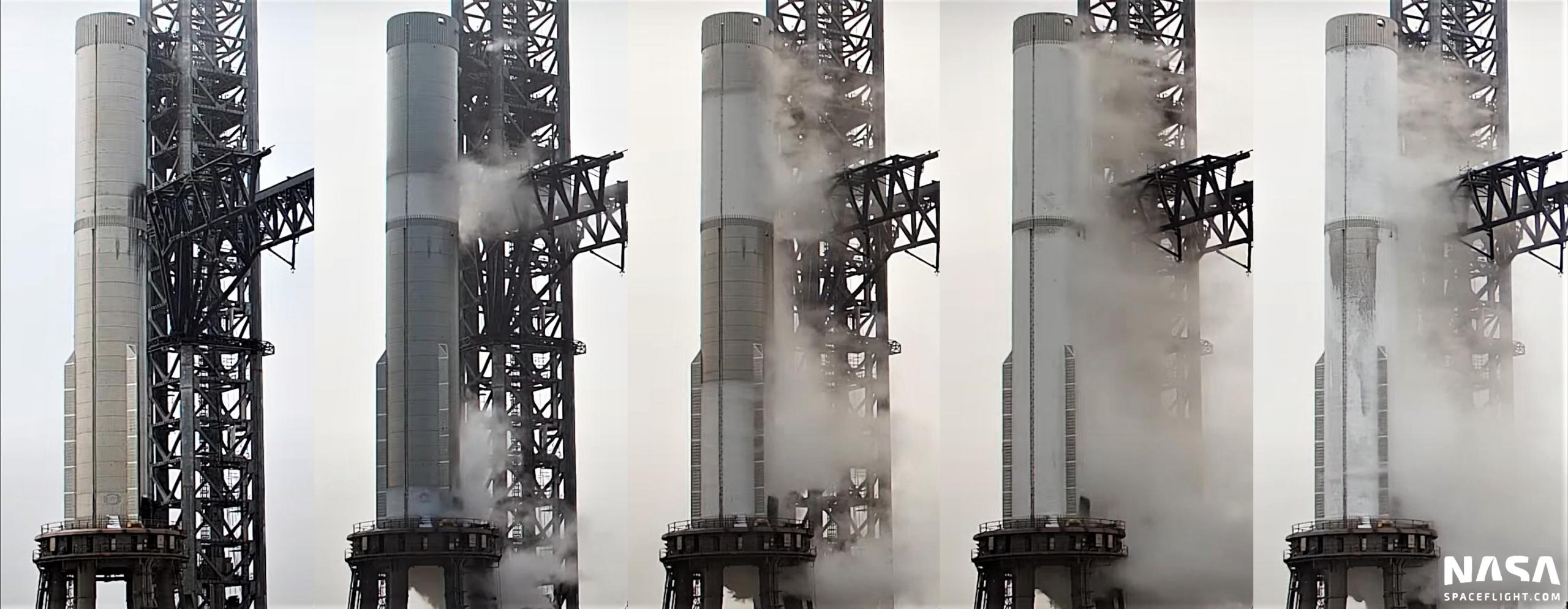

News
SpaceX’s upgraded Super Heavy booster sails through first major test
SpaceX’s first upgraded 33-engine Super Heavy booster appears to have passed a crucial test with surprising ease, boding well for a smooth qualification process.
Attempting that test so early on did not appear to be SpaceX’s initial plan. Instead, shortly before Super Heavy Booster 4’s third and likely final removal from Starbase’s ‘orbital launch mount’ (OLM) on March 24th, SpaceX transported a massive structural test stand from a Starbase storage yard to the orbital launch site (OLS), where technicians have focused on modifying nearby ground systems to support apparent structural testing of Super Heavy Booster 7. As of March 31st, all available evidence suggested that SpaceX was preparing that stand to verify Booster 7’s mechanical strength and simulate the major stresses it might experience before investing a significant amount of time and resources in qualification testing.
However, SpaceX appeared to change its plans at the last minute.
Instead of starting with structural testing, after a brief two-day pause, SpaceX rolled Super Heavy B7 into place and craned the giant booster onto the orbital launch mount on April 2nd. On April 3rd, the launch mount’s “quick disconnect” device connected Super Heavy to the pad’s ground systems. On April 4th, just two days after its installation on the OLM, Super Heavy B7 kicked off the first in a series of qualification tests that will determine when or if the booster ultimately supports Starship’s first orbital launch attempt.
If testing goes perfectly, SpaceX CEO Elon Musk recently stated that Starship and Super Heavy – likely Ship 24 and Booster 7 – could be ready for an inaugural orbital launch attempt as early as May 2022. SpaceX appears to have leaped headfirst into Super Heavy Booster 7 qualification testing in a move that significantly increases the likelihood of meeting that extremely ambitious schedule. Normally, with a first-of-its-kind prototype debuting multiple significant design changes, SpaceX would start slow, possibly beginning with a basic pneumatic proof test to verify structural integrity at flight pressures – about 6.5-8.5 bar (95-125 psi) – with benign nitrogen gas before calling it a day.
With Booster 7, SpaceX likely still performed a quick pneumatic proof but then immediately proceeded into a full-scale cryogenic proof test. With Super Heavy B4, for example, SpaceX performed several increasingly ambitious cryogenic proof tests, filling the booster more and more each attempt but never actually topping it off. On Booster 7’s very first day of testing and first cryogenic proof attempt, SpaceX fully loaded the upgraded Super Heavy with a cryogenic fluid (likely liquid nitrogen) in just two hours – all with no significant unplanned holds (pauses).
In those two hours, SpaceX likely loaded Super Heavy B7’s liquid methane (LCH4) and oxygen (LOx) tanks with roughly 3400 metric tons (~7.5M lb) of liquid nitrogen (LN2) – not far off what Super Heavy would actually weigh at liftoff. At the peak of the test, Booster 7 was almost entirely covered in a thin layer of ice produced as the cryogenic liquid inside its tanks froze water vapor in the humid South Texas air onto its skin – an effect that effectively turns uninsulated cryogenic rockets into giant fill gauges. On top of running into no apparent issues, Super Heavy B7’s first cryogenic proof is also the first time any Super Heavy prototype has been fully filled during testing – an important milestone for any rocket prototype, let alone the largest rocket booster ever built.
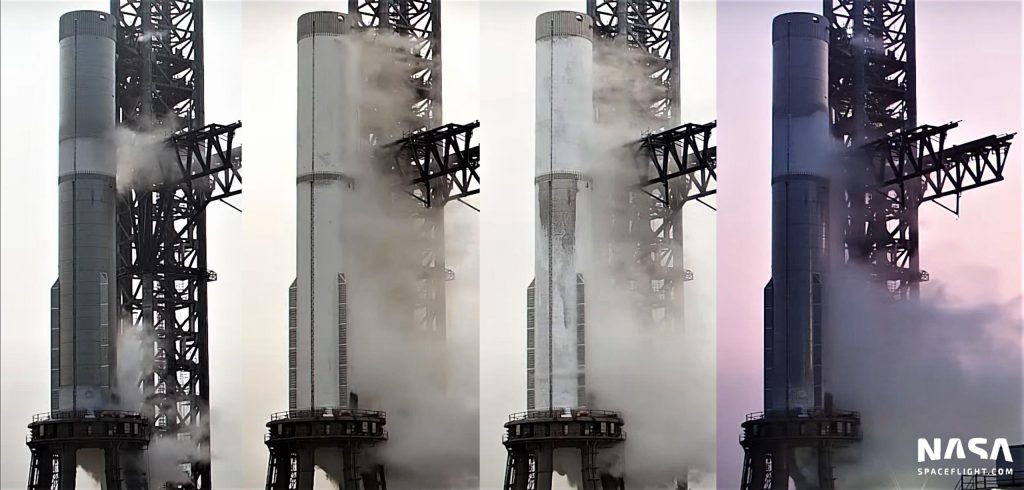
Completing a full cryogenic proof test on its first try makes Booster 7 fairly unique among all Starship prototypes – not just Super Heavies. The contrast with Booster 4, which barely completed a handful of partial cryogenic proof tests in more than half a year spent at Starbase’s orbital launch site, is also extremely encouraging, suggesting that Booster 7 won’t be sitting inactive for months at a time.
Still, cryogenic proofing is just one of several important tests Booster 7 needs to complete. Even if the first test was nearly perfect and SpaceX doesn’t attempt one or several more cryoproofs with higher tank pressures or other tweaked variables, Super Heavy B7 needs to complete wet dress rehearsal testing (WDR) with flammable LCH4/LOx propellant and demonstrate autogenous pressurization (using heated propellant gas to pressure its tanks). At some point, SpaceX will also need to install a full 33 Raptor V2 engines on the booster and seal off the whole engine section and each Raptor with a heat shield.
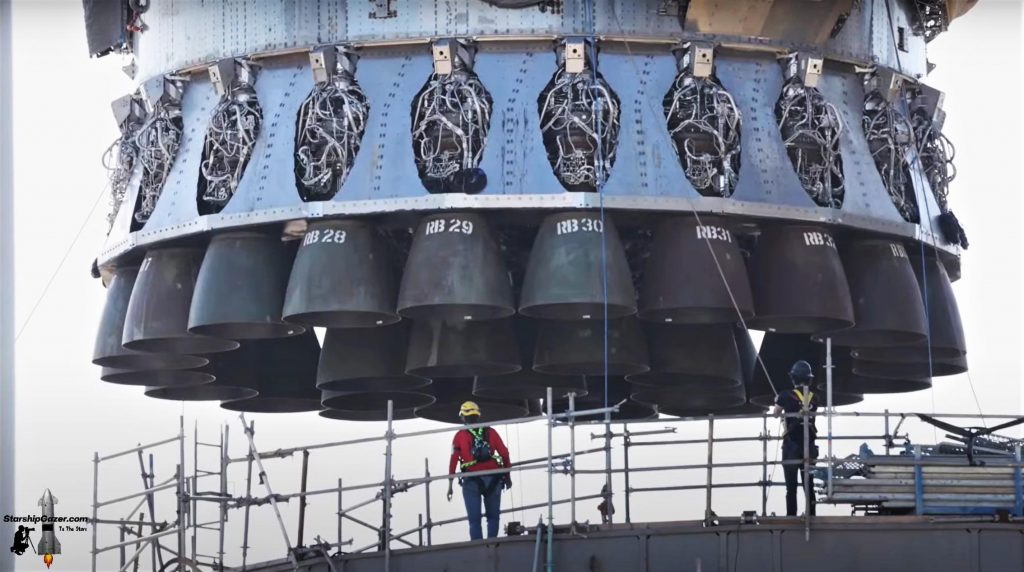
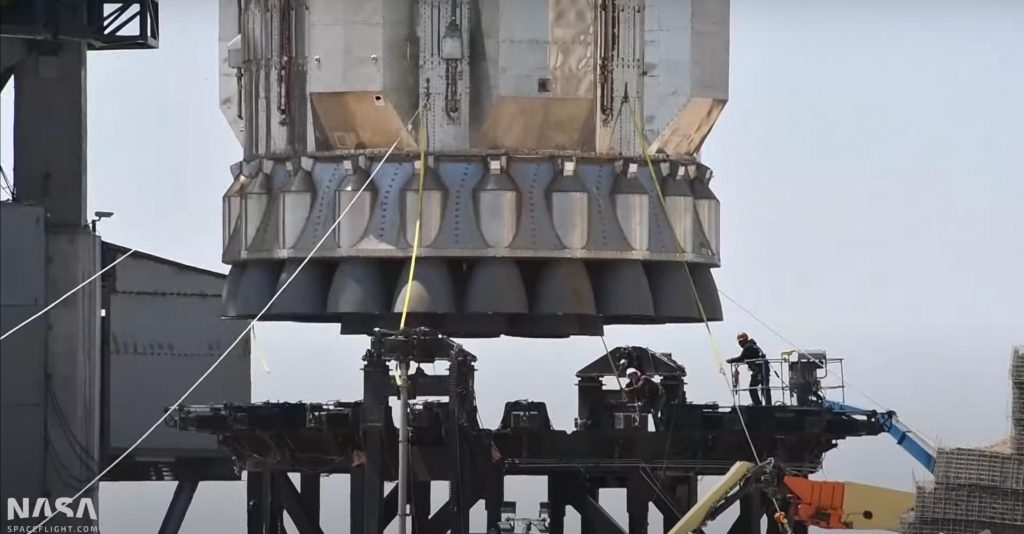
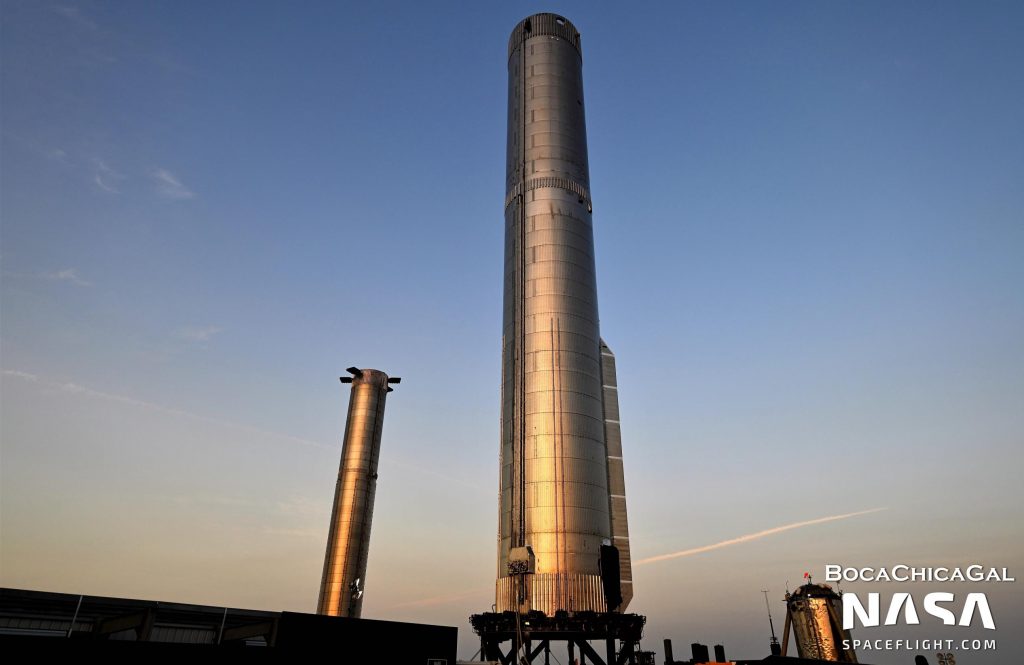
Depending on how many Raptor V2 engines are available, SpaceX could begin static fire testing with just a few engines installed and shielded and then install the rest of the engines and heat shield later on. On the other hand, performing static fires without a full heat shield could risk damaging unprotected cabling or other subsystems, in which case wet dress rehearsal testing would likely follow immediately after cryoproofing and before engine or shield installation. After being skipped over, the structural test stand may also factor into Booster 7 qualification sometime before engine installation.
All told, plenty of uncertainty remains, but Super Heavy B7’s auspicious start suggests that the Booster 4 experience is far from a template and that SpaceX is much less interested in wasting time this time around.
News
Tesla UK sales see 14% year-over-year rebound in June: SMMT data
The SMMT stated that Tesla sales grew 14% year-over-year to 7,719 units in June 2025.

Tesla’s sales in the United Kingdom rose in June, climbing 14% year-over-year to 7,719 units, as per data from the Society of Motor Manufacturers and Traders (SMMT). The spike in the company’s sales coincided with the first deliveries of the updated Model Y last month.
Model Y deliveries support Tesla’s UK recovery
Tesla’s June performance marked one of its strongest months in the UK so far this year, with new Model Y deliveries contributing significantly to the company’s momentum.
While the SMMT listed Tesla with 7,719 deliveries in June, independent data from New AutoMotive suggested that the electric vehicle maker registered 7,891 units during the month instead. However, year-to-date figures for Tesla remain 2% down compared to 2024, as per a report from Reuters.
While Tesla made a strong showing in June, rivals are also growing. Chinese automaker BYD saw UK sales rise nearly fourfold to 2,498 units, while Ford posted the highest EV growth among major automakers, with a more than fourfold increase in the first half of 2025.
Overall, the UK’s battery electric vehicle (BEV) demand surged 39% to to 47,354 units last month, helping push total new car sales in the UK to 191,316 units, up 6.7% from the same period in 2024.
EV adoption accelerates, but concerns linger
June marked the best month for UK car sales since 2019, though the SMMT cautioned that growth in the electric vehicle sector remains heavily dependent on discounting and support programs. Still, one in four new vehicle buyers in June chose a battery electric vehicle.
SMMT Chief Executive Mike Hawes noted that despite strong BEV demand, sales levels are still below regulatory targets. “Further growth in sales, and the sector will rely on increased and improved charging facilities to boost mainstream electric vehicle adoption,” Hawes stated.
Also taking effect this week was a new US-UK trade deal, which lowers tariffs on UK car exports to the United States from 27.5% to 10%. The agreement could benefit UK-based EV producers aiming to expand across the country.
News
Tesla Model 3 ranks as the safest new car in Europe for 2025, per Euro NCAP tests
Despite being on the market longer than many of its rivals, the Tesla Model 3 continues to set the bar for vehicle safety.

The Tesla Model 3 has been named the safest new car on sale in 2025, according to the latest results from the Euro NCAP. Among 20 newly tested vehicles, the Model 3 emerged at the top of the list, scoring an impressive 359 out of 400 possible points across all major safety categories.
Tesla Model 3’s safety systems
Despite being on the market longer than many of its rivals, the Tesla Model 3 continues to set the bar for vehicle safety. Under Euro NCAP’s stricter 2025 testing protocols, the electric sedan earned 90% for adult occupant protection, 93% for child occupant protection, 89% for pedestrian protection, and 87% for its Safety Assist systems.
The updated Model 3 received particular praise for its advanced driver assistance features, including Tesla’s autonomous emergency braking (AEB) system, which performed well across various test scenarios. Its Intelligent Speed Assistance and child presence detection system were cited as noteworthy features as well, as per a WhatCar report.
Other notable safety features include the Model 3’s pedestrian-friendly pop-up hood and robust crash protection for both front and side collisions. Euro NCAP also highlighted the Model 3’s ability to detect vulnerable road users during complex maneuvers, such as turning across oncoming traffic.
Euro NCAP’s Autopilot caution
While the Model 3’s safety scores were impressive across the board, Euro NCAP did raise concerns about driver expectations of Tesla’s Autopilot system. The organization warned that some owners may overestimate the system’s capabilities, potentially leading to misuse or inattention behind the wheel. Even so, the Model 3 remained the highest-scoring vehicle tested under Euro NCAP’s updated criteria this year.
The Euro NCAP’s concerns are also quite interesting because Tesla’s Full Self-Driving (FSD) Supervised, which is arguably the company’s most robust safety suite, is not allowed for public rollout in Europe yet. FSD Supervised would allow the Model 3 to navigate inner city streets with only minimal human supervision.
Other top scorers included the Volkswagen ID.7, Polestar 3, and Geely EX5, but none matched the Model 3’s total score or consistency across categories. A total of 14 out of 20 newly tested cars earned five stars, while several models, including the Kia EV3, MG ZS, and Renault 5, fell short of the top rating.
Elon Musk
Why Tesla’s Q3 could be one of its biggest quarters in history
Tesla could stand to benefit from the removal of the $7,500 EV tax credit at the end of Q3.

Tesla has gotten off to a slow start in 2025, as the first half of the year has not been one to remember from a delivery perspective.
However, Q3 could end up being one of the best the company has had in history, with the United States potentially being a major contributor to what might reverse a slow start to the year.
Earlier today, the United States’ House of Representatives officially passed President Trump’s “Big Beautiful Bill,” after it made its way through the Senate earlier this week. The bill will head to President Trump, as he looks to sign it before his July 4 deadline.
The Bill will effectively bring closure to the $7,500 EV tax credit, which will end on September 30, 2025. This means, over the next three months in the United States, those who are looking to buy an EV will have their last chance to take advantage of the credit. EVs will then be, for most people, $7,500 more expensive, in essence.
The tax credit is available to any single filer who makes under $150,000 per year, $225,000 a year to a head of household, and $300,000 to couples filing jointly.
Ending the tax credit was expected with the Trump administration, as his policies have leaned significantly toward reliance on fossil fuels, ending what he calls an “EV mandate.” He has used this phrase several times in disagreements with Tesla CEO Elon Musk.
Nevertheless, those who have been on the fence about buying a Tesla, or any EV, for that matter, will have some decisions to make in the next three months. While all companies will stand to benefit from this time crunch, Tesla could be the true winner because of its sheer volume.
If things are done correctly, meaning if Tesla can also offer incentives like 0% APR, special pricing on leasing or financing, or other advantages (like free Red, White, and Blue for a short period of time in celebration of Independence Day), it could see some real volume in sales this quarter.
You can now buy a Tesla in Red, White, and Blue for free until July 14 https://t.co/iAwhaRFOH0
— TESLARATI (@Teslarati) July 3, 2025
Tesla is just a shade under 721,000 deliveries for the year, so it’s on pace for roughly 1.4 million for 2025. This would be a decrease from the 1.8 million cars it delivered in each of the last two years. Traditionally, the second half of the year has produced Tesla’s strongest quarters. Its top three quarters in terms of deliveries are Q4 2024 with 495,570 vehicles, Q4 2023 with 484,507 vehicles, and Q3 2024 with 462,890 vehicles.
-

 Elon Musk4 days ago
Elon Musk4 days agoTesla investors will be shocked by Jim Cramer’s latest assessment
-

 News1 week ago
News1 week agoTesla Robotaxi’s biggest challenge seems to be this one thing
-

 Elon Musk2 weeks ago
Elon Musk2 weeks agoFirst Look at Tesla’s Robotaxi App: features, design, and more
-

 News2 weeks ago
News2 weeks agoSpaceX and Elon Musk share insights on Starship Ship 36’s RUD
-

 News2 weeks ago
News2 weeks agoWatch Tesla’s first driverless public Robotaxi rides in Texas
-

 News1 week ago
News1 week agoWatch the first true Tesla Robotaxi intervention by safety monitor
-

 News2 weeks ago
News2 weeks agoTesla has started rolling out initial round of Robotaxi invites
-

 Elon Musk2 weeks ago
Elon Musk2 weeks agoTesla to launch in India in July with vehicles already arriving: report


















